By Ahmed Fergiani

Preface
Our knowledge of the historical maritime trade in the Mediterranean Sea is based on poetry, myths, fables, inscriptions left on buildings, objects and ancient letters. This knowledge remains poor, however, if we don’t consider another important source, the mosaics. In Roman mosaics, there is ample evidence of the trade, transport of goods and logistics for supplying wild animals to the Roman Amphitheatre. The mosaics discovered in different areas around the Mediterranean Sea are extraordinary evidence of many goods that Rome imported through its harbour at Ostia for more than three centuries. To get a better understanding of the maritime trade, we are going to discuss the Roman ports and the maritime trade depicted in those African and Sicilian mosaics.
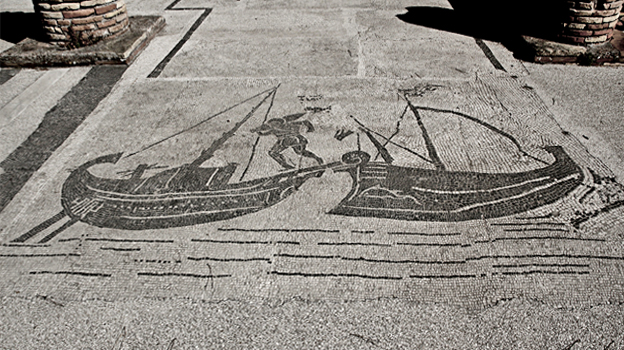
Roman mosaics from northern Africa and Sicily.
When the Romans expanded their empire in Africa after the end of the Punic wars, thousands of mosaic floor pavements were used to adorn the city villas and country houses of the African upper classes. Between the first and sixth centuries A.D, mosaic art was frequently applied, particularly in the region of Africa Proconsularis, the region comprising modern Tunisia and western Libya. These artworks are remarkable for their figural scenes depicting and documenting everyday life of the maritime trade and they give quite a full picture of the Roman harbours in North Africa from where their major export was sent to Ostia, the final destination of the African trade routes to Rome.
The port town of Ostia is situated at the mouth of the River Tiber, 15 miles away from Rome which meant a journey from Africa of between three and five days, according to Pliny the elder2.
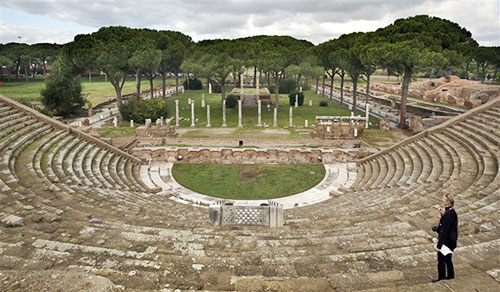
The trade, shipping and logistics were operated by numerous Mediterranean shipping companies, partly represented in Ostia by their agents who worked at stationes (commercial offices) in the nowadays called Piazzale delle Corporazioni3, the large market plaza behind the theatre where we still have many unique black and white mosaics technically known as Opus Tesselatum.
Ostia gives us a clear idea about the unloading and the logistics, as it was impossible for big merchantmen to navigate upstream the Tiber towards Rome. Small ships called lenunculus had this capability but many slaves and workers were needed to trans-ship the cargo. On one of the stationes (statio 25) we see two ships with their stems turned to each other while a worker is engaged in unloading the amphorae (photo 2).
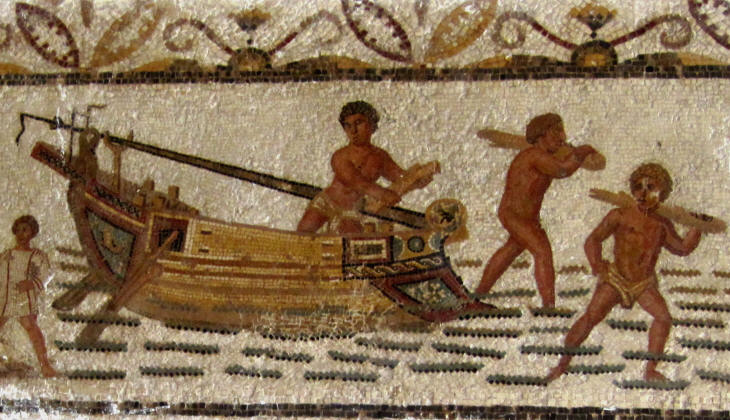
Similar scenes of unloading ships were found in the mosaics of the Tunisian city of Chemtou (photo 4).
The naves onerariae were ships particularly suited for transporting these commodities over the Mediterranean to Rome. Their movement was mainly based on sails and they were relatively wide.
The mosaics found in North Africa depict ships in a rather sketchy way, nevertheless they provide information about some of their technical features. The ships exported goods like olive oil, slaves, wild animals, wines and a fish sauce called Garum.
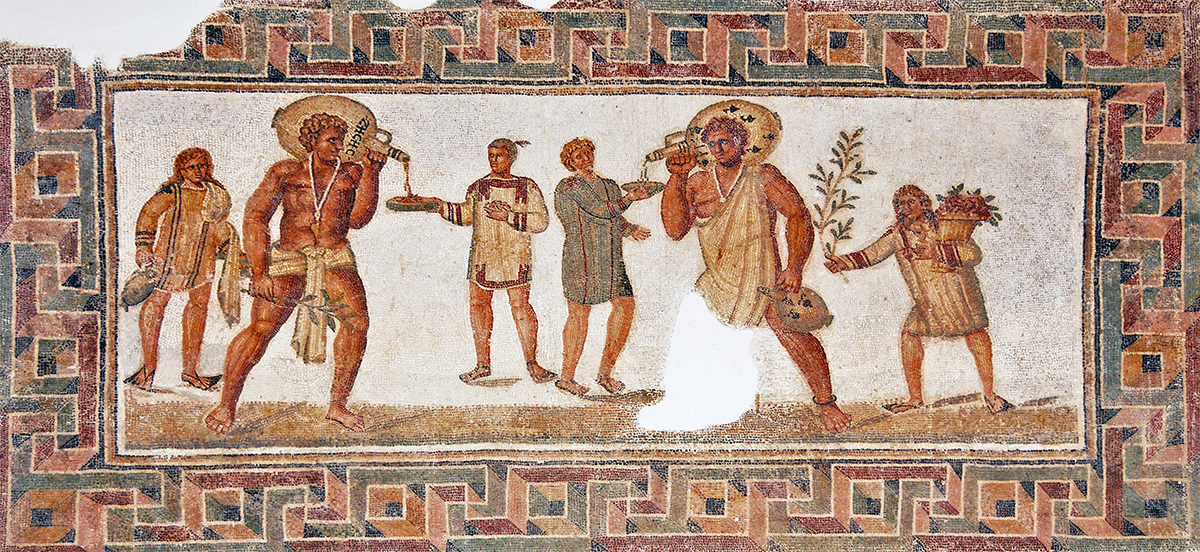
At Dougga (Photo 5) a mosaic in the dining room was meant to invite guests to enjoy their meal and wine. It portrays two giant slaves pouring wine to guests from large amphorae. On the right amphora is written the Greek word PIE (drink!), to which the left one replies with the Greek word ZHCHC (and you will live!).
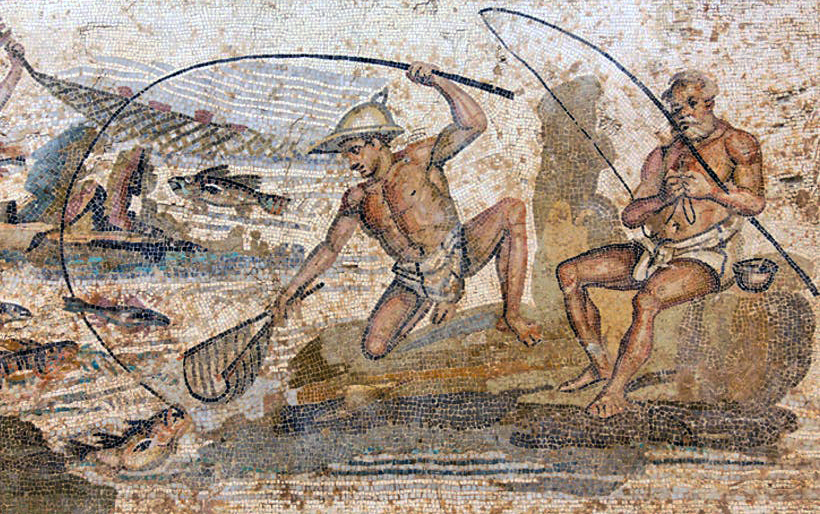
The highly appreciated fish sauce named Garum was imported from many North African ports where fishing was one of the activities of the inhabitants as we see in the mosaics of the Libyan city of Leptis Magna (Photo 6).
Another feature of the Roman maritime trade was that of live animals, brought from Africa to end up, most of the time, slaughtered in the Colisseum of Rome.
Other animals including crocodiles, hyenas and gazelles were probably used in triumphal parades or maybe in the Venationes, a type of public spectacle that featured animal hunts, sponsored by emperors and wealthy citizens who would also prefer certain animals to adorn their villas.
The most spectacular example comes from the 4th-century AD mosaic from the Villa Romana del Casale in the Sicilian city of Piazza Armerina (Photo 7), which depict scenes of transporting those animals on Roman ships.
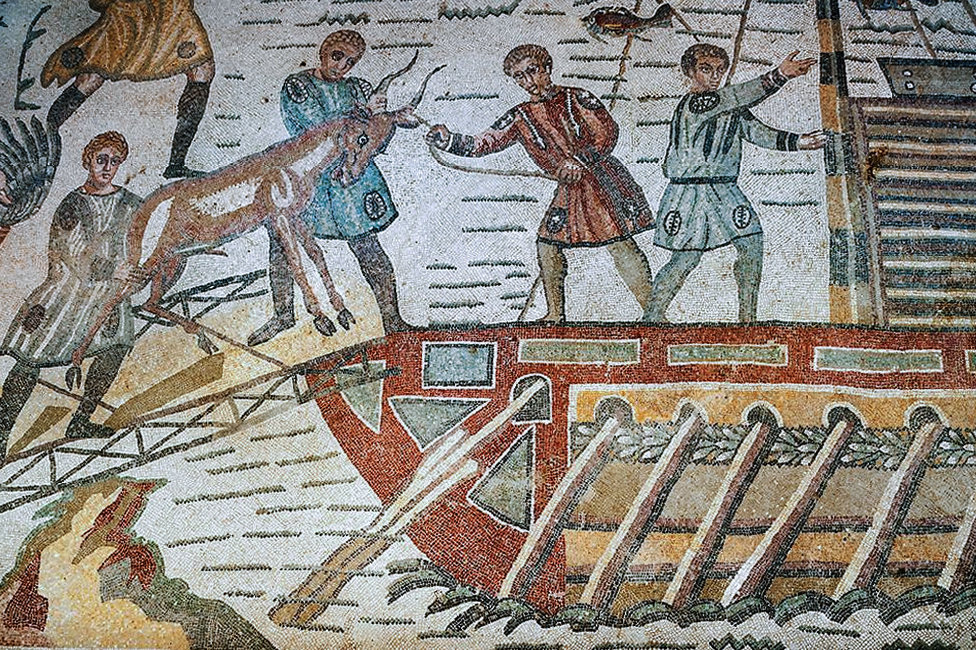
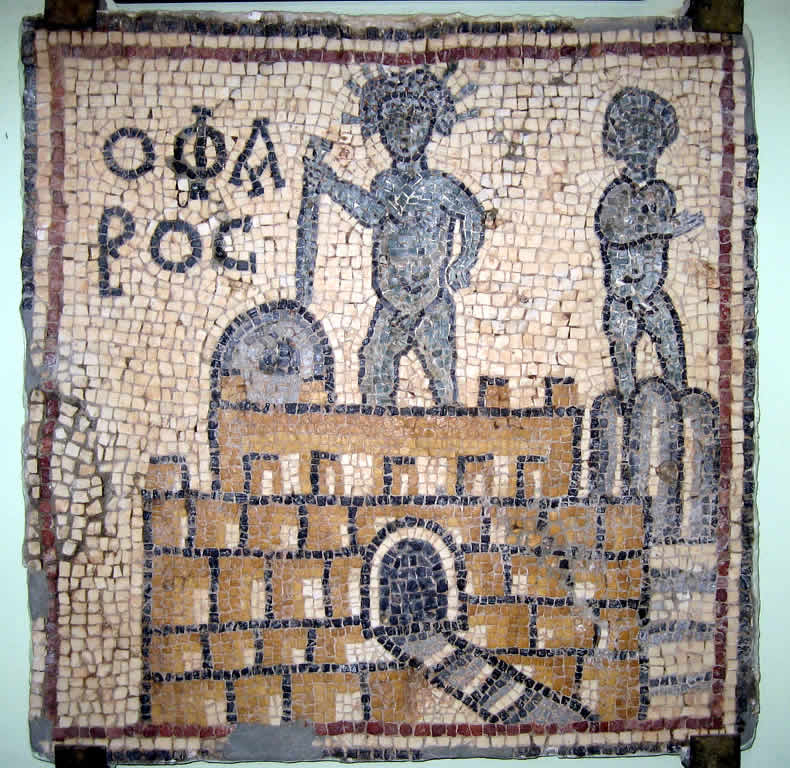
The Roman mosaics document also another important feature of the maritime trade: the lighthouse. Most notably is the famous light house of Alexandria depicted on the Byzantine mosaics from the city of Qasr in Libya (Photo 8), a town that seems to be still inhabited by pagans in the 6th century despite the triumph of Christianity after the year 313 AD.
Also on the Piazzale delle Corporazioni at Ostia we see several mosaics depicting a lighthouse. In this case it's the lighthouse of Claudius at Portus (see article 'Overseas trade')
Sailing was not always a walkover in the ancient Mediterranean. A rough sea could be a real threat and the Romans believed that a divine help would make it possible for them to master the unknown forces in that sea. Many mosaics in North Africa illustrate the fear and the need of that divine help.
The mosaics of the Nilus Villa of Leptis Magna (Photo 9) are a perfect proof of what a storm or a rough sea meant to those sailors. The mosaic panel reveals anxious cupids (sailors) rushing to reach the harbour with their boat clearly pushed by strong winds as we understand from the sails. Other cupids prefer to jump on fast dolphins rather than to stay on that boat. On the right side we see the harbour of leptis magna..
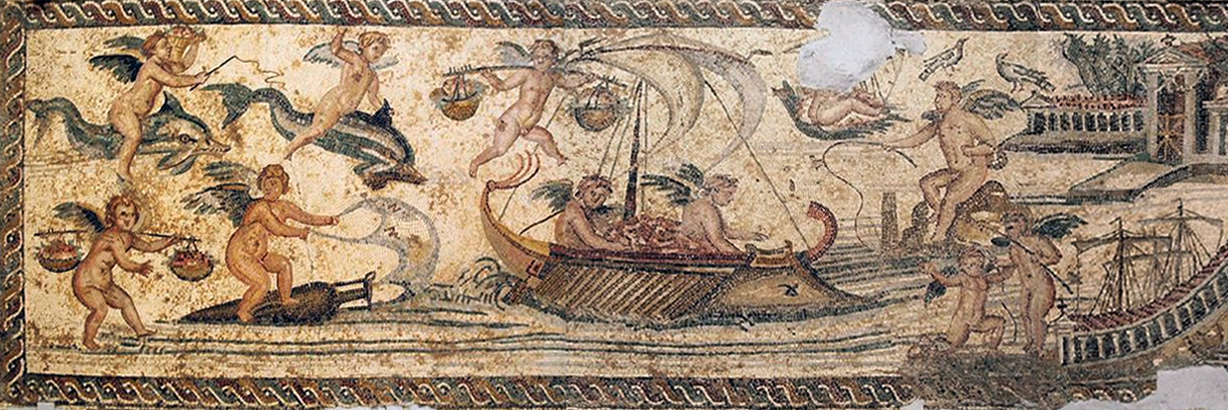
The Pirates were another feared issue for which those sailors required a divine help. The Tunisian mosaics of Bardo (Photo 10) depict Dionysus sailing in a boat and defeating the pirates with his panthers. A clear evidence of the deities’ help, while the Roman mosaics from the Moroccan Volubulis (Photo 11) depict a sailing Venus, hoping for prosperity, peace and divine love.
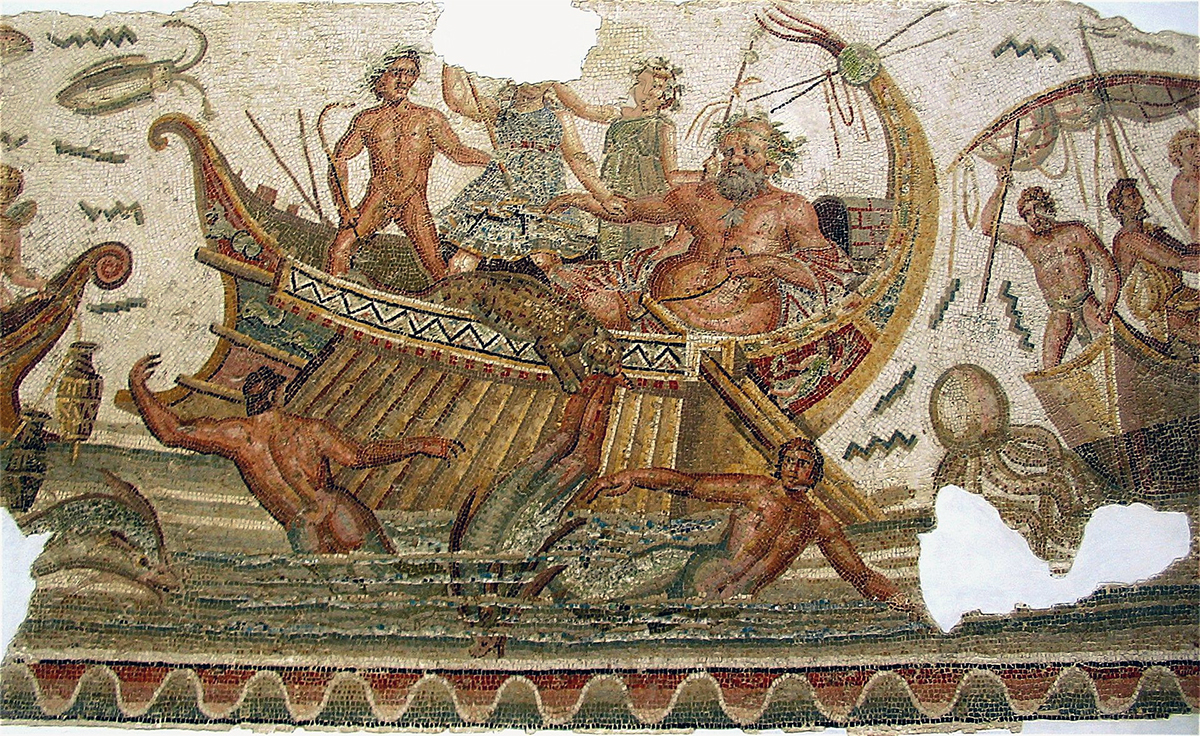
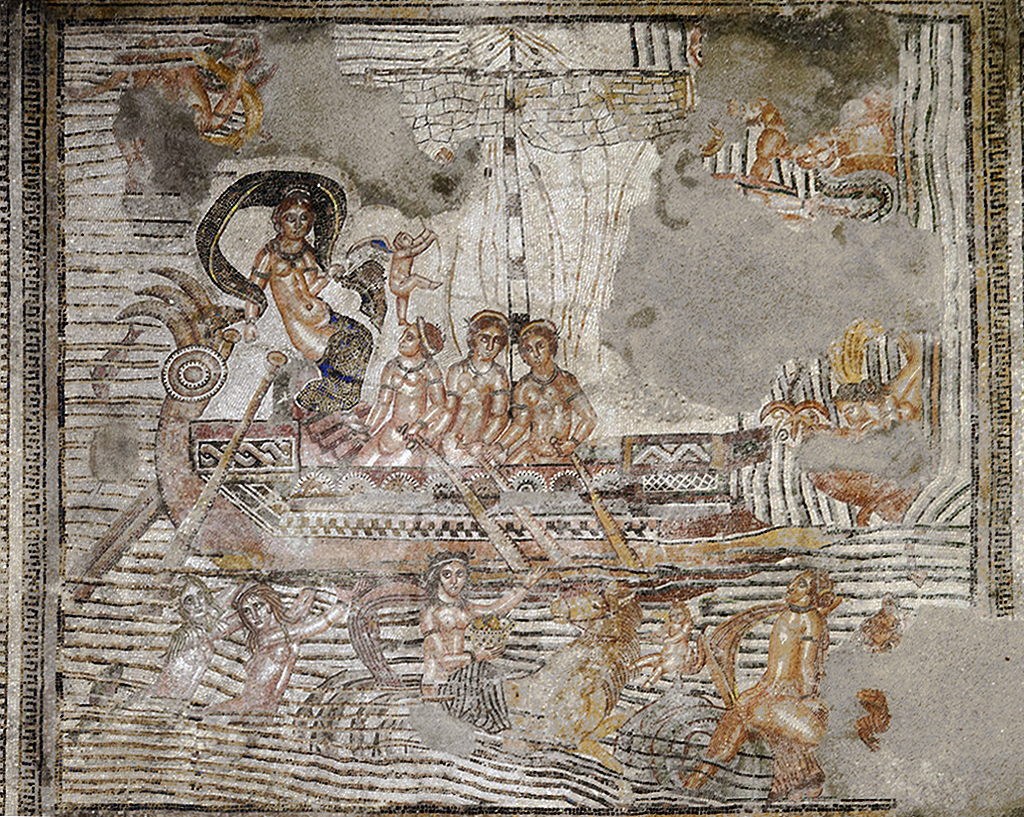
- notes:
- 1: Mosaic from Veii (Isola Farnese) Today in the Badisches Landesmuseum Karlsruhe Germany. Photo: Carole Raddato
- 2: Plinius: Nat. Hist. 19,3-4
- 3: See article 'Overseas trade'
- 4: Photo 3: Laura Maish-Bill Storage
- 5: Mosaic from Chemtou (Today in museum Bardo)
- 6: Mosaic from Dougga (3rd century AD). Photo Dennis Jarvis
- 7: Villa of the Nile, near Leptis Magna at Libya. 2nd century AD. Today in Jamahiriya museum-Tripoli.
- 8: Mosaic from the Villa Romana del Casale. Pizza Armerina Sicily. (3rd century AD).
- 9: Photo 8: David Stanley.
- 10: Ulysses mosaic. Bardo National museum, Photo: Dennis Jarvis
- 11: Mosaic from the House with the same name at Volubilis (Marocco)





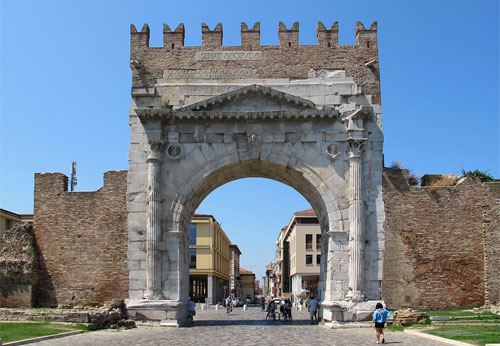
 We are committed to providing versions of our articles and interviews in several languages, but our first language is English.
We are committed to providing versions of our articles and interviews in several languages, but our first language is English.